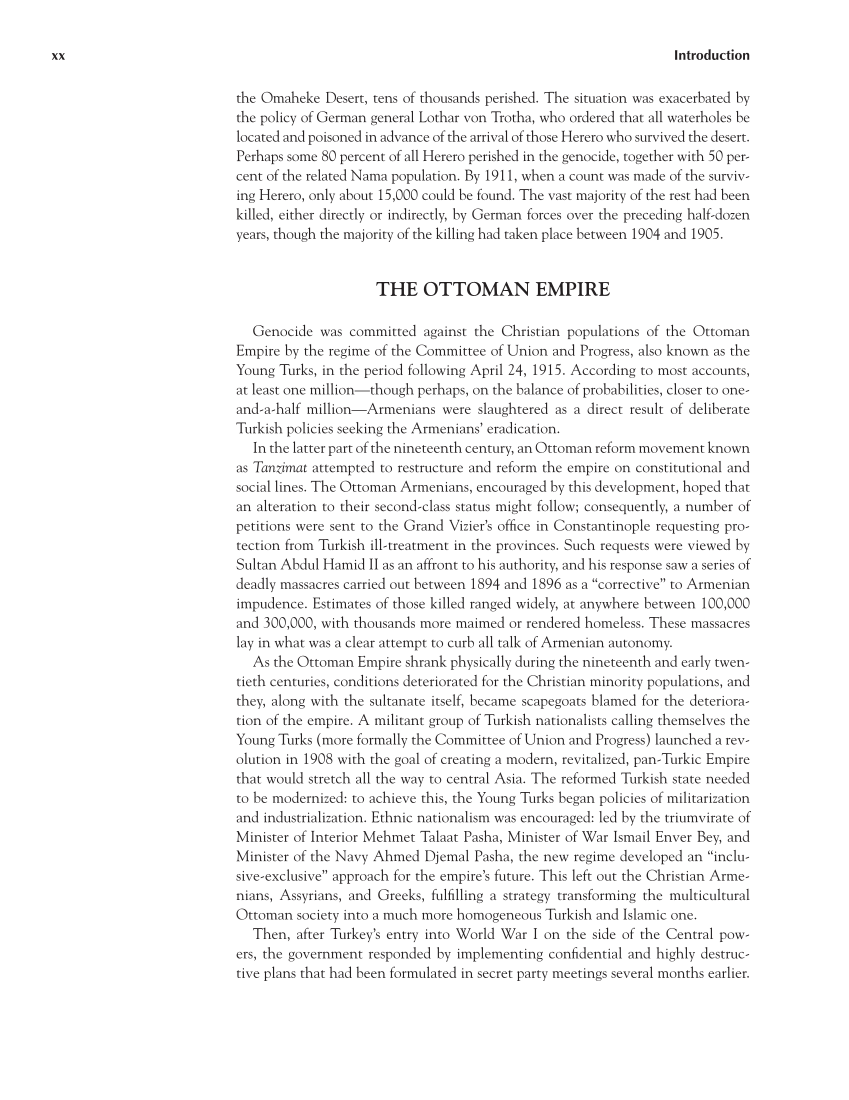xx Introduction the Omaheke Desert, tens of thousands perished. The situation was exacerbated by the policy of German general Lothar von Trotha, who ordered that all waterholes be located and poisoned in advance of the arrival of those Herero who survived the desert. Perhaps some 80 percent of all Herero perished in the genocide, together with 50 per- cent of the related Nama population. By 1911, when a count was made of the surviv- ing Herero, only about 15,000 could be found. The vast majority of the rest had been killed, either directly or indirectly, by German forces over the preceding half-dozen years, though the majority of the killing had taken place between 1904 and 1905. THE OTTOMAN EMPIRE Genocide was committed against the Christian populations of the Ottoman Empire by the regime of the Committee of Union and Progress, also known as the Young Turks, in the period following April 24, 1915. According to most accounts, at least one million—though perhaps, on the balance of probabilities, closer to one- and-a-half million—Armenians were slaughtered as a direct result of deliberate Turkish policies seeking the Armenians’ eradication. In the latter part of the nineteenth century, an Ottoman reform movement known as Tanzimat attempted to restructure and reform the empire on constitutional and social lines. The Ottoman Armenians, encouraged by this development, hoped that an alteration to their second-class status might follow consequently, a number of petitions were sent to the Grand Vizier’s office in Constantinople requesting pro- tection from Turkish ill-treatment in the provinces. Such requests were viewed by Sultan Abdul Hamid II as an affront to his authority, and his response saw a series of deadly massacres carried out between 1894 and 1896 as a “corrective” to Armenian impudence. Estimates of those killed ranged widely, at anywhere between 100,000 and 300,000, with thousands more maimed or rendered homeless. These massacres lay in what was a clear attempt to curb all talk of Armenian autonomy. As the Ottoman Empire shrank physically during the nineteenth and early twen- tieth centuries, conditions deteriorated for the Christian minority populations, and they, along with the sultanate itself, became scapegoats blamed for the deteriora- tion of the empire. A militant group of Turkish nationalists calling themselves the Young Turks (more formally the Committee of Union and Progress) launched a rev- olution in 1908 with the goal of creating a modern, revitalized, pan-Turkic Empire that would stretch all the way to central Asia. The reformed Turkish state needed to be modernized: to achieve this, the Young Turks began policies of militarization and industrialization. Ethnic nationalism was encouraged: led by the triumvirate of Minister of Interior Mehmet Talaat Pasha, Minister of War Ismail Enver Bey, and Minister of the Navy Ahmed Djemal Pasha, the new regime developed an “inclu- sive-exclusive” approach for the empire’s future. This left out the Christian Arme- nians, Assyrians, and Greeks, fulfilling a strategy transforming the multicultural Ottoman society into a much more homogeneous Turkish and Islamic one. Then, after Turkey’s entry into World War I on the side of the Central pow- ers, the government responded by implementing confidential and highly destruc- tive plans that had been formulated in secret party meetings several months earlier.
Document Details My Account Print multiple pages
Print
You have printed 0 times in the last 24 hours.
Your print count will reset on at .
You may print 0 more time(s) before then.
You may print a maximum of 0 pages at a time.


































































































































































































































































































































































































